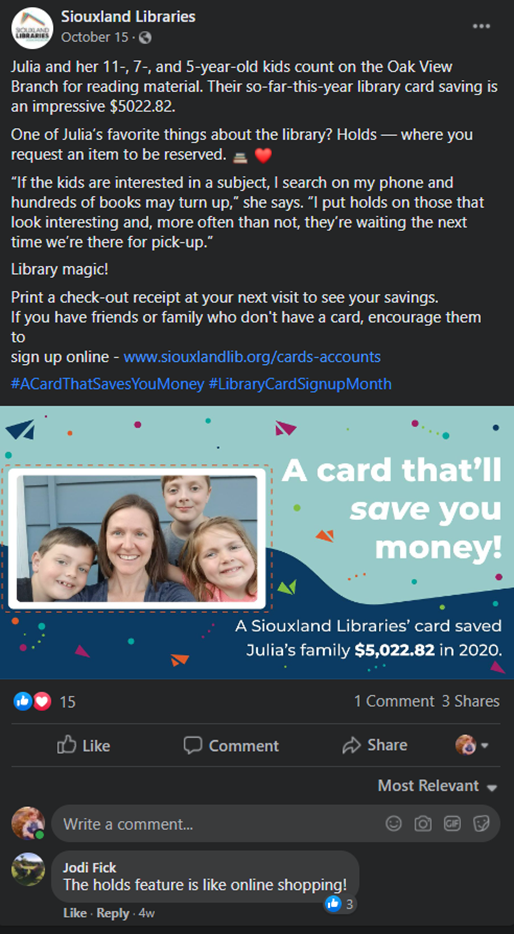Three Stories Your Library Should Be Telling Right Now
Most of the time, library promotion involves a lot of announcements like, “We offer homework help” or “We’ve got a new website” or “Come to our program.” These promotions are informative, but they lack the one magical thing that people respond to: emotion.

By Angela Hursh, Senior Engagement Consultant, NoveList
In the days before COVID, my daughter and I would attend the annual Jane Austen Festival at Locust Grove in Louisville, Kentucky. One of our favorite parts of the festival happened in the basement of the main house. There, a man named Pat Richardson would spend all day telling English folk tales. His wife Becky would act out the story using shadow puppets and candles behind a gauzy curtain. Every time my daughter and I negotiated the narrow stone steps to the cool cellar and sat down on the plain wooden benches to listen to Pat and Becky weave stories of danger, mystery, and magic, we were transported.
People have told stories for as long as humans could communicate. Stories are used to share news, amplify the accomplishments of heroes, pass on cultural traditions, and transfer knowledge and history. Stories make complex information easier to understand. And stories can change the future of your library, for the better.
Most of the time, library promotion involves a lot of announcements like, “We offer homework help” or “We’ve got a new website” or “Come to our program.” These promotions are informative, but they lack the one magical thing that people respond to: emotion.
Your library can use stories to create an emotional connection between your community and your library. This is a key component of a successful advocacy plan. There is research and data to prove that storytelling works. The content personalization firm OneSpot found that 92 percent of consumers want promotional messages that come in the form of a story, with engaging images that will make an impact on their minds and hearts. They expect your promotions to inspire them.
Your library storytelling should start now, even if your library isn’t currently seeking funding or voter support. Telling your library’s story is good strategy. And there is so much that a story can do for your library, no matter the size of staff or community. Here are three stories your library can tell right now as tools of advocacy.
Story #1: Your library adds real value to the community. You know that your library makes a difference. But instead of just saying that, paint a picture with real life examples of people whose lives were changed by your library.
In the fall of 2020, Siouxland Libraries launched a targeted storytelling campaign to coincide with Library Card Sign-up Month. The campaign, which ran on all library social media platforms and in the library’s newsletter, featured nine community members who shared how much money they saved using a library card and, in some instances, what they did with that extra cash. Betsy Rice, who does communications and marketing for the city of Sioux Falls, said of the project, “Customers have expressed both delight and amazement at the amount of money Siouxland Libraries has saved them. It’s been more darn fun!”

Story #2: Your library adapts to changing needs. Past perception of libraries is a real hurdle. Most people think the library is the same as it was 50 years ago. They have no idea how much you’ve grown and transformed. But there are plenty of stories that will demonstrate of the dynamic modern work of your library.
A notable example of this comes from the Cincinnati and Hamilton County Public Library blog. The library’s shipping manager, Matthew Todd, published a post in January describing how library staff mobilized to help with distribution of pandemic-related supplies, first delivering PPE (personal protective equipment) early in 2020 and then again to deliver vaccines. Now, when a community member sees a library truck, they’ll think not only about the books and items being delivered, but also about the role this organization played in helping to end the pandemic.
Story #3: Your library fills an essential need in your community.
The Bridges Library System in Wisconsin created an entire section of their website where they share stories of how community members use library programs and services. Every story is compelling, but the one that really struck a chord with me was the story of Elizabeth and her daughter Marie. Elizabeth lives with dementia and Marie brings her to the library for enrichment activities like the Memory Café and movie nights. The interview with the mother-daughter pair is short, but there is a lot of emotion in the text and accompanying photo.

There are seven more ways that stories can raise awareness and garner stakeholder support of your library! If you are concerned about budget cuts, need to seek additional funding, or want to demonstrate the relevancy of your library, an advocacy plan is essential. A NoveList expert can guide you in developing, implementing, and measuring an effective strategy for telling your library’s story in a way that’s sustainable and tailored to your library’s specific needs. You’ll learn the components of good storytelling, how to find compelling stories that support your strategic goals, and how to successfully share those stories with your community. Learn more about NoveList's deep-dive course in Telling Your Library’s story and to request a free consultation.
SPONSORED BY
RELATED
ALREADY A SUBSCRIBER? LOG IN
We are currently offering this content for free. Sign up now to activate your personal profile, where you can save articles for future viewing










Add Comment :-
Comment Policy:
Comment should not be empty !!!